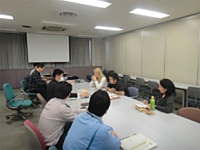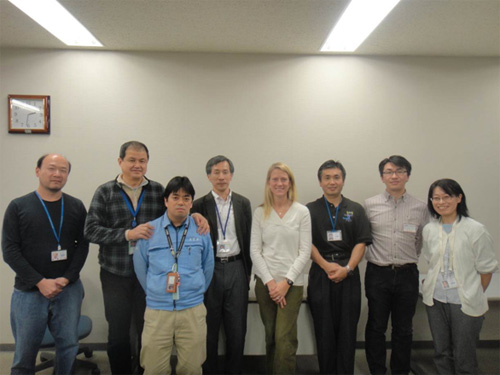This is an archive of information released in the past.
Disclaimer: It may contain broken links or outdated information. Some parts may not function in current web browsers.
*Visit https://humans-in-space.jaxa.jp/en/ for the latest information.

Experiment
- News
- Kibo Utilization Strategy
- Kibo Utilization Plan
- List of JAXA's Utilization Themes
- Experiment Facilities
- Space Environment Utilization
- Archive
The state of ground research and of preparations for the space experiments
Last updated: May 30, 2013
1. Training astronauts for the experiment (February 22, 2013)
An explanation of the significance of the Aniso Tubule experiment and of the equipment and materials to be used was given to the 35S crew members, Astronaut Karen L. Nyberg and Astronaut Wakata. The participants eagerly discussed the experimental procedure, equipment and materials to be used, as well as the significance of the experiment, for 30 minutes.
The Aniso Tubule experiment was proposed by Associate Professor Kouichi Soga of Osaka City University. He belongs to the same laboratory as Professor Hoson, the Principal Investigator of the Resist Tubule experiment, and they have been performing investigations together for a long time, beginning with an experiment conducted in the STS-95 Space Shuttle mission. They are also collaborating on each other’s present experiments.


A trainer and Associate Professor Soga explaining the experiment to Astronaut Karen L. Nyberg and Astronaut Wakata.

A photo of the members of the research team: (From left) Associate Professor Hashimoto, the JAXA staff member in charge of the Resist Tubule experiment; Dr. Shimazu of the Japan Space Forum; Dr. Kamata of Advanced Engineering Services Co., Ltd.; Professor Hoson of Osaka City University, who is also the PI of the Resist Tubule experiment; Astronaut Karen L. Nyberg; Astronaut Wakata; Associate Professor Soga of Osaka City University, who is the PI of the Aniso Tubule experiment; and Dr. Yano, the JAXA staff member in charge of the Aniso Tubule experiment.
Schedule
- Science symposium (May 29, 2013)
- Sow seeds of Arabidopsis in sample cassettes for the space experiment (approximately in the first week of July 2013).
- Transport the sample cassettes to Tanegashima (scheduled for the middle of July 2013).
- Start the first experiment
- Finish the first experiment (2013).
- Start the second experiment.
- Finish the second experiment.
| Copyright 2007 Japan Aerospace Exploration Agency | Site Policy |